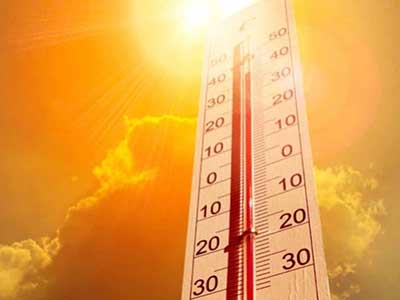Relevance: GS-1: Important Geophysical phenomena such as climate change, Heatwave.
Key Phrases: Heat wave, Indian Meteorological Department, Favourable conditions, hot dry air, moisture, cloudless, anti-cyclonic flow, global warming, high temperature, western disturbances, higher humidity, India’s monsoon.
Why in News?
- What is driving up temperatures beyond normal in north, west, central and east India?
Context:
- India is in the throes of an unusually long series of heatwaves that began in the end of March and scorched north India for most of April. The India Meteorological Department (IMD) said April was the hottest in northwest India in 122 years, with temperatures touching above 40 degree Celsius in large parts of Bihar, Jharkhand and West Bengal.
Definition of Heat wave:
- The Indian Meteorological Department (IMD) describes a heatwave as a condition of air temperature which might prove to be fatal to human beings if exposed to it. Whereas, quantitatively a heat wave is defined based on the temperature thresholds over a region in terms of actual temperature or its departure from normal.
- A heatwave is declared when the maximum temperature is over 40 degree Celsius and at least 4.5 notches above normal. A severe heatwave is declared if the departure from normal temperature is more than 6.4 degrees, according to the IMD. Based on absolute recorded temperatures, a heatwave is declared when an area logs a maximum temperature of 45 degree Celsius. A severe heatwave is declared if the maximum temperature crosses 47 degree Celsius.
How Widespread is The Heatwave?
- Records from IMD suggest that the average maximum temperature till April 27 was 35.7 degree Celsius, the highest in five years for this month. In Madhya Pradesh, Rajasthan, Punjab, and Gujarat, the average maximum temperature in April 2022 so far has been the highest since 1951, while it has been the second highest in Delhi, Uttar Pradesh, and Haryana. In most of these States, the temperature has been consistently above 42 degree Celsius and around 5-6 degrees above normal for this time of the year.
- Latest IMD forecasts say heat wave conditions will prevail in many parts of Punjab, northwest Rajasthan and Vidarbha, Maharashtra. It’s also unusually hot in parts of Himachal Pradesh, west Madhya Pradesh, Jharkhand, Bihar, Gangetic West Bengal and Odisha.
Favourable Conditions For Heat Wave:
- Transportation / Prevalence of hot dry air over a region: There should be a region of warm dry air and appropriate flow pattern for transporting hot air over the region.
- Absence of moisture in the upper atmosphere: The presence of moisture restricts the temperature rise.
- Sky should be practically cloudless: To allow maximum insulation over the region.
- Large amplitude anti-cyclonic flow over the area.
- Heat waves generally develop over Northwest India and spread gradually eastwards & southwards but not westwards (since the prevailing winds during the season are westerly to north-westerly). But on some occasions, heat wave may also develop over any region in situ under the favourable conditions.
Is Climate Change Responsible?
- The heat-trapping consequences of global warming imply that climate extremes such as heatwaves are expected to rise in frequency.
- The main reason for the scorching heat in the northern parts of the country is lack of rainfall. Usually, periods of high temperature are punctuated by periodic episodes of rain but this was largely absent during March and April.
- Ironically, April also saw maximum instances of extreme rainfall since 2018 though it was concentrated in the south and north-eastern India. The rain-bearing western disturbances originate because of temperature gradients between the northernmost parts of the globe and the latitudes passing through West Asia. Weaker gradients mean weaker rains. This March and April, cooler than normal conditions in the Pacific Ocean failed to aid rainfall in north India.
What Impact Do Heatwaves Have Over India?
- Research through the years shows that the number of heatwave days in India is increasing every decade. From 413 in 1981-90 to 575 in 2001-10 and 600 in 2011-20, the number of days that see extremely hot days is persistently increasing at 103 weather stations. Some parts along eastern India, such as Andhra Pradesh, Telangana and Odisha, also register higher humidity along with high temperatures, leading to a rise in a condition called ‘wet bulb’ temperature, which can cause extreme discomfort and at its worst cause dehydration and death.
- Heatwaves have killed more than 17,000 people in 50 years in India, according to a research study by IMD scientists. However, the intensity and length of heatwaves don’t have a direct connection to India’s monsoon that sets in over Kerala in June.
Way Forward:
- Over the years, forecast systems have improved that allow heatwave warnings to be disseminated via electronic channels and phones instantaneously. Many State governments across the country have declared school holidays, some have highlighted the dangers of working outdoors during the day.
Source: The Hindu
Mains Question:
Q. What are heat waves ? What are favourable conditions for Heat wave? Suggest measures to create buffer against high temperatures? Comment. (250words).







